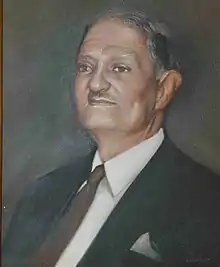Second Cabinet of Khaled Chehab | |
|---|---|
Cabinet of Lebanon | |
 Painting of Khaled Chehab | |
| Date formed | 30 September 1952 |
| Date dissolved | 30 April 1953 |
| People and organisations | |
| President | Camille Chamoun |
| Head of government | Khaled Chehab |
| No. of ministers | 4 |
| Total no. of members | 4 |
| History | |
| Predecessor | Military Cabinet of Fouad Chehab |
| Successor | Second Cabinet of Saeb Salam |
The second cabinet led by Khaled Chehab was formed under President Camille Chamoun on 30 September 1952.[1][2] Its establishment occurred in the aftermath of the 1952 crisis in Lebanon.[3] The cabinet was not only given confidence vote, but also power to enforce laws via decree-laws to reform the Lebanese administrative and legislative bodies until February 1953.[4][5]
The period of the cabinet was brief, and it was dissolved on 30 April 1953.[2][6][7] Saeb Salam was given the task to form the next cabinet.[4]
Cabinet members
The cabinet was consisted of four members.[4][8] They were not a member of the Lebanese Parliament.[9]
The cabinet members were as follows:[1][10]
- Prime Minister: Khalid Chehab
- Foreign Minister, Minister of Public Works and PTT: Musa Mubarak
- Minister of Defense, Minister of Education, Minister of Health and Social Affairs: Salim Haidar
- Minister of Finance and Minister of Economy and Agriculture: George Hakim
In addition to his premiership Khalid Chehab also held the following posts in the cabinet: minister of interior, minister of justice and minister of information.[10]
On 6 February 1953 Minister of Defense Salim Haidar resigned from the office, and the number of the cabinet members decreased to three.[2]
References
- 1 2 "Foreign Relations of the United States, 1952–1954, The Near and Middle East, Volume IX, Part 1 Document 549". Office of the Historian. 26 January 1953. Retrieved 12 April 2022.
- 1 2 3 Elie Salem (Autumn 1967). "Cabinet Politics in Lebanon". The Middle East Journal. 21 (4): 494. JSTOR 4324201.
- ↑ J. L. (April 1953). "Peaceful Change in the Lebanon: The 'Rose-Water' Revolution". The World Today. 9 (4): 171. JSTOR 40392618.
- 1 2 3 Hani A. Bazzi (1964). The Lebanese Executive between 1934 and 1963 (MA thesis). American University of Beirut. pp. 55–56. ProQuest 2323545294.
- ↑ Tarek Abou Jaoude (2021). "Chehabism revisited: the consequences of reform in Lebanon". Middle Eastern Studies. 57 (5): 811. doi:10.1080/00263206.2021.1891891. S2CID 233707775.
- ↑ Barry Turner, ed. (2017). The Statesman's Yearbook 2009: The Politics, Cultures and Economies of the World. New York: Palgrave Macmillan. p. 780. ISBN 978-1-349-74027-7.
- ↑ Farid El Khazen (2020). The Breakdown of the State in Lebanon, 1967–1976. London; New York: I.B. Tauris. p. 246. ISBN 978-0-7556-1816-3.
- ↑ Caroline Camille Attie (1996). Lebanon in the 1950s: President Chamoun and Western policy in Lebanon (PhD thesis). University of Texas at Austin. p. 56. ISBN 9798691260339. ProQuest 304273708.
- ↑ Caroline Attie (2003). Struggle in the Levant: Lebanon in the 1950s. London; New York: I.B. Tauris. p. 51. ISBN 978-0-85771-710-8.
- 1 2 Who's Who in Lebanon (19th ed.). Beirut: Publitec Publications. 2007. p. 484. doi:10.1515/9783110945904.476. ISBN 978-3-598-07734-0.